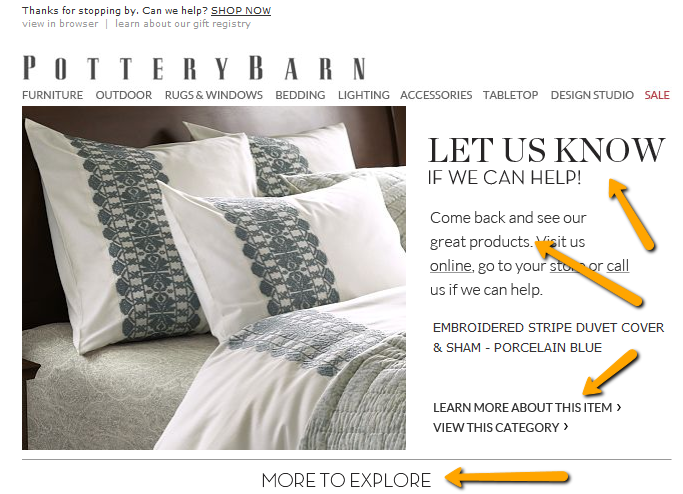This article about email strategy appeared on HubSpot and is reprinted on Savvy-Writer with permission.
If you’re in an e-commerce business, you’re probably very familiar with the challenge of “abandoned carts”. Every day, ecommerce businesses lose out on sales when potential customers abandon their online shopping carts. Many of these people will return, and some more qualified to purchase than before. Let’s explore how you can leverage abandoned shopping cart lead intelligence with marketing automation to boost your e-commerce remarketing activities.
8 Common Motivations for Abandoned Shopping Carts
First, let’s surface some of the potential reasons for shopping cart abandonment:
- The buyer ran out of time to complete the purchase.
- The buyer is surprised by the shipping charges.
- The buyer wasn’t ready to make the purchase.
- The buyer is comparison shopping.
- The internet connection failed.
- The shopping cart has expired.
- The buyer found a better price.
- Product availability changed.
The good news is that, in 75% of these scenarios, you still have an interested buyer. The trick is striking while the iron is hot. Chances are, the longer you wait to contact the potential buyer, the more likely she is to change her mind or buy from someone else. To make sure you’re jumping on these potentially lost opportunities quickly, set in place the following 3-step action plan to remind and entice potential buyers to make their purchases.
Create Your E-commerce Marketing Automation Action Plan
Step 1: Set a Series of Automated Reminder Emails
Keep the momentum of the purchase process going! Create an email marketing automation campaign that consists of 1 to 3 emails and launches within 24 hours of the initial cart abandonment. Tap into the potential buyer’s decision-making process by addressing some of the abandonment motivations directly. Most importantly, be sure to leverage any special deals or promotions, and use these special promotions and inventory to create a sense of urgency.
Here are some sample emails to get you started. We suggest using 1 to 3 variations of these emails to kick-start your campaign (or run an A/B test to see which is most successful for your target customers).

- Example Email #1 – Send a Reminder Email: For buyers who ran out of time, didn’t have access to a credit card, or had a faulty internet connection, remind them there are still products sitting in their shopping cart.
- Example Email #2 – Show Your Expertise: For buyers who are comparing two similar products, send them product reviews or information.
- Example Email #3 – Reduce Friction: For buyers who quit during the checkout process, consider sending them a coupon for free shipping.
- Example Email #4 – Provide Some Incentive: For buyers who have been comparison shopping, consider offering a promotion to sweeten the deal.
- Bonus Email – Add Some Urgency! Running low on inventory? Send a warning to customers that the products in their shopping carts may sell out. This can be applied to any of the emails above.
Cautionary note: Don’t train repeat shopping cart abandoners to expect a discount! Vary your marketing automation campaigns to include other information such as product reviews and videos, new product releases, or fun and interactive content to help build brand awareness.
Step 2: Personalize the Return Visit
Supplement your marketing automation email campaign with personalized messaging. The next time your customer visits your website, welcome her back and remind her that she still has items in her shopping cart.

A few factors to consider when performing remarketing on your website are:
- Design: Consider the wording, layout, and coupon incentive placement. Even subtle design components such as color or the images used in a message can impact a customer’s decision to make a purchase or not.
- Duration: Consider the length of your offer. As many online shopping carts have an expiration date, it is often wise to give an expiration date for the offer, too. Shortening the promotional period also adds a sense of urgency.
- Consistency: Be careful not to send mixed messages. Be consistent with the offers you are providing in your emails.
Step 3: Learn From Your Experiences
You can’t always win…right away. Some buyers may take months to buy a new television set or a printer for their office. Don’t be disheartened, and don’t forget to use the lead intelligence you’ve gained.
- Test timing and discounts. Don’t be afraid to experiment with different techniques before settling on a few that you’ll use regularly.
- Analyze. Determine which types of customers respond best to your re-marketing efforts, and use this information to develop your customer personas.
- Measure. Track shopping cart abandonment rates month-over-month to determine how closely the rates align with your promotions.
Nurtured leads produce sales opportunities over non-nurtured leads. By developing, iterating, and analyzing your marketing automation efforts, you will be on the path to success in no time.
About the author
Rebecca Gutner
LinkedIn: https://www.linkedin.com/in/rebeccagutner/
Rebecca is a Director of Professional Services at HubSpot. Rebecca is Flexible, nimble and high-spirited, Rebecca enjoys taking on new challenges and keeping up with a fast-paced, ever-changing work environment. Her Specialties: inbound marketing, demand generation, email marketing, search engine optimization, people management, marketing consulting.
Liked this post? Click here and sign up for the Savvy-Writer newsletter.
